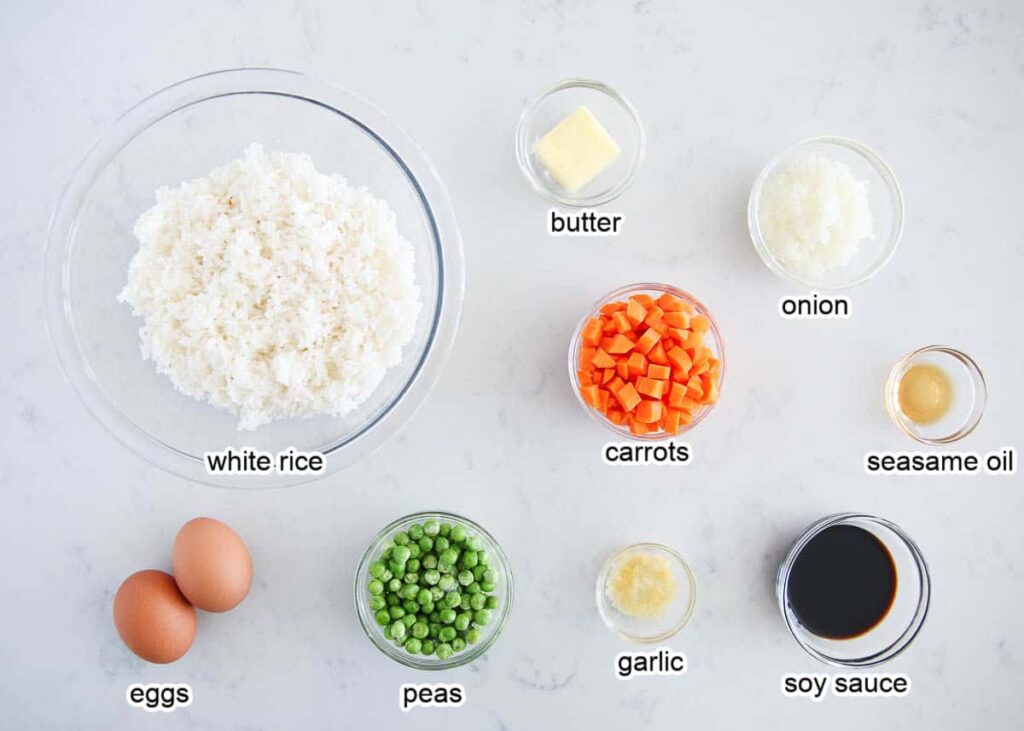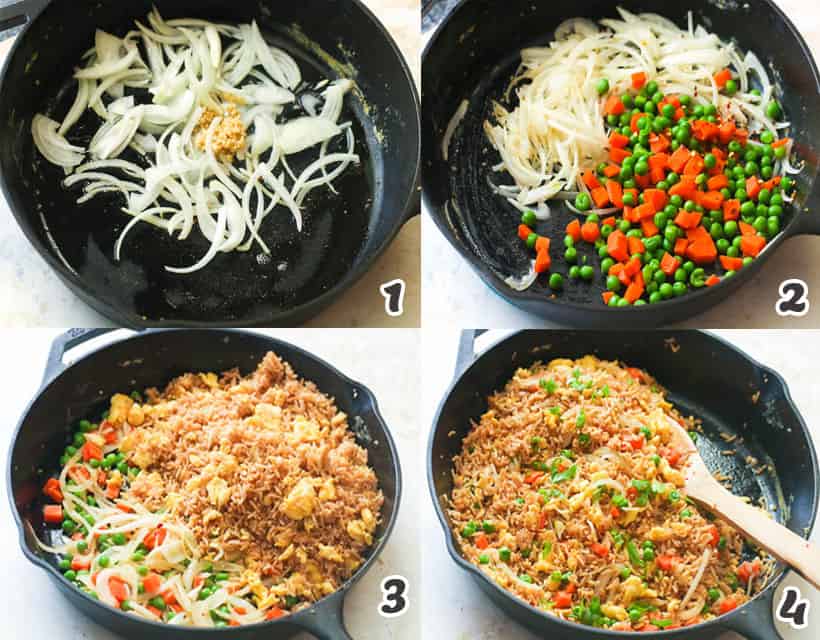
How to Cook Fried Rice: Easy and Quick Method
Here we can guide you How to Cook Fried Rice? Fried rice is a popular and versatile dish made by stir-frying cooked rice with various ingredients, including vegetables, proteins, and seasonings. It is a staple in many Asian cuisines, particularly Chinese, and is known for its savory flavor and satisfying texture. Here’s a detailed look at what fried rice entails:
Key Takeaways
Rice: Typically, fried rice is made with leftover rice that has been cooked and then cooled, ideally from the previous day. This ensures the rice grains are dry and separate, preventing a mushy texture.
Oil: Vegetable oil, canola oil, or sesame oil are commonly used for stir-frying. Sesame oil adds a distinct nutty flavor.
Aromatics: Ingredients such as garlic, onions, and ginger are often used to add depth and aroma to the dish.
Vegetables: Common vegetables include peas, carrots, corn, bell peppers, and green onions. I dice and stir-fry them to add texture and nutrition.
Protein: Fried rice can include a variety of proteins such as eggs, chicken, shrimp, beef, pork, or tofu. The protein is usually cooked first and then mixed into the rice.
Seasonings: Soy sauce is a primary seasoning, providing a salty and umami flavor. We can use oyster sauce, fish sauce, and a bit of salt and pepper to enhance the taste ourselves.
Eggs: Eggs are often scrambled and mixed into the rice, adding richness and a subtle flavor.
Learn More Recipe: How to Cook Wild Rice
Ingredients:
3 cups cooked rice (preferably day-old, cold rice)
2 tablespoons vegetable oil (or any cooking oil)
1 medium onion, finely chopped
2 cloves garlic, minced
1 cup mixed vegetables (such as peas, carrots, and corn), diced
2 eggs, beaten
3 tablespoons soy sauce
1 tablespoon oyster sauce (optional)
2 teaspoon sesame oil (optional)
1 cup cooked protein (like shrimp, chicken, pork, or tofu), diced
2 green onions, sliced
Salt and pepper, to taste

Instructions:
Prepare the Ingredients:
Dice all vegetables and proteins.
Beat the eggs in a small bowl.
If using day-old rice, break up any clumps to make it easier to stir-fry.
Cook the Eggs:
Heat 1 tablespoon of oil in a large skillet or wok over medium-high heat.
Pour in the beaten eggs and scramble until fully cooked. Remove them from the skillet and set aside.
Stir-Fry the Vegetables:
Mix remaining tablespoon of oil to the skillet.
Add chopped onions and garlic, stir-fry for about 1-2 minutes until fragrant.
Mixed vegetables and cook for another 3-4 minutes until they are tender.
Add the Rice:
cold, cooked rice to the skillet.
Stir continuously to break up clumps and heat the rice through, about 5 minutes.
Combine Everything:
Return the scrambled eggs to the skillet, along with the cooked protein.
Pour in the soy sauce, oyster sauce (if using), and sesame oil (if using).
Stir everything together until well combined and the rice is evenly coated with the sauces.

Finish and Serve:
Add the sliced green onions and stir to combine.
Season with salt and pepper to taste.
Serve hot, garnished with additional green onions if desired.
Learn More Recipe: How To Cook Jasmine Rice
FAQ:
Can I use freshly cooked rice to make fried rice?
While you can use freshly cooked rice, it’s best to use day-old, cold rice. Fresh rice is too moist and can result in clumpy, mushy fried rice. Day-old rice is drier and separates better.
What type of rice is best for fried rice?
Medium to long-grain rice, such as jasmine or basmati, works well for fried rice. These types of rice remain fluffy and separate when stir-fried.
Do I need a wok to make fried rice?
A wok is ideal for making fried rice due to its shape, which allows for easy tossing and even cooking. However, a large, heavy-bottomed skillet or frying pan can also be used effectively.
What kind of oil should I use?
Use a high-heat oil such as vegetable oil, canola oil, or peanut oil. Sesame oil can be added towards the end for flavor but isn’t suitable for high-heat cooking.
How do I prevent my fried rice from sticking to the pan?
Heat your pan or wok properly before adding oil. Stir frequently and make sure the rice is dry (day-old rice is best). Using enough oil also helps prevent sticking.
How can I add more flavor to my fried rice?
In addition to soy sauce, you can use oyster sauce, fish sauce, hoisin sauce, or a bit of sesame oil for extra flavor. Garlic, ginger, and green onions also enhance the taste.
Should I cook the eggs separately?
Yes, it’s best to cook the eggs separately and then set them aside before adding them back into the fried rice towards the end. This prevents the eggs from overcooking and allows them to remain fluffy.
Can I add raw vegetables to fried rice?
Yes, but chop them into small, uniform pieces so they cook quickly. You should add harder vegetables like carrots first, and softer vegetables like peas or bell peppers later.
How can I make my fried rice healthier?
Use brown rice or cauliflower rice for a lower-carb option. Add plenty of vegetables, use lean proteins, and limit the amount of oil and high-sodium sauces.
Can I make fried rice without soy sauce?
Yes, you can use alternatives like tamari (a gluten-free option), coconut aminos, or a mixture of salt and other seasonings. These can provide a similar umami flavor without soy.
How long can I store leftover fried rice?
Store leftover fried rice in an airtight container in the refrigerator for up to 3-4 days. Reheat it thoroughly before eating.
Can I freeze fried rice?
Yes, fried rice freezes well. Store it in an airtight container or freezer bag for up to 2-3 months. Thaw in the refrigerator before reheating.
Why is my fried rice bland?
Ensure you’re using enough seasoning, like soy sauce or other sauces. Cooking the rice with aromatics like garlic and onion also enhances the flavor. Taste and adjust the seasoning before serving.
Learn More Recipe: How To Cook Rice On Stove